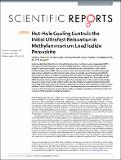Hot-Hole cooling controls the initial ultrafast relaxation in methylammonium lead iodide perovskite
Abstract
Understanding the initial ultrafast excited state dynamics of methylammonium lead iodide (MAPI) perovskite is of vital importance to enable its fullest utilisation in optoelectronic devices and the design of improved materials. Here we have combined advanced measurements of the ultrafast photoluminescence from MAPI films up to 0.6 eV above the relaxed excited state with cutting-edge advanced non-adiabatic quantum dynamics simulations, to provide a powerful unique insight into the earliest time behaviour in MAPI. Our joint experimental-theoretical approach highlights that the cooling of holes from deep in the valence band to the valence band edge is fast, occurring on a 100-500 fs timescale. Cooling of electrons from high in the conduction band to the conduction band edge, however, is much slower, on the order of 1-10 ps. Density of states calculations indicate that excited states with holes deep in the valence band are greatly favoured upon photoexcitation, and this matches well with the fast (100-500 fs) formation time for the relaxed excited state observed in our ultrafast PL measurements. Consequently we are able to provide a complete observation of the initial excited state evolution in this important prototypical material.
Citation
Hedley , G J , Quarti , C , Harwell , J R , Prezhdo , O , Beljonne , D & Samuel , I D W 2018 , ' Hot-Hole cooling controls the initial ultrafast relaxation in methylammonium lead iodide perovskite ' , Scientific Reports , vol. 8 , 8115 . https://doi.org/10.1038/s41598-018-26207-9
Publication
Scientific Reports
Status
Peer reviewed
ISSN
2045-2322Type
Journal article
Description
Funding: EPSRC (grants EP/J009016 and EP/L017008) and the European Research Council (grant 321305). IDWS acknowledges a Royal Society Wolfson Research Merit Award.Collections
Items in the St Andrews Research Repository are protected by copyright, with all rights reserved, unless otherwise indicated.

